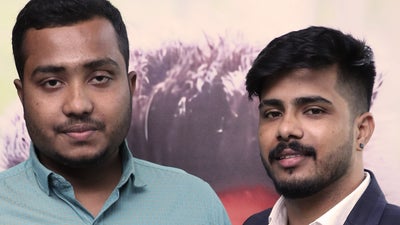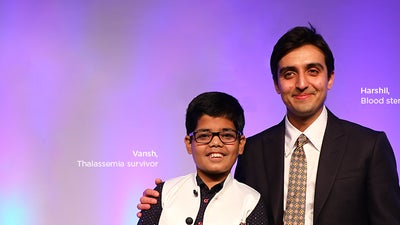German-Indian friendship: Maheer and his lifesaver
How a stem cell donation kindled a wonderful connection
A stem cell donation by Dr. Sita Arjuna, a medical doctor from Cologne, saved the life of Maheer, a blood cancer patient in India. Four years later, the two met face to face. They’ve since developed a friendship that spans the continents. Sita had planned to return Maheers visit by going to see him in India last year – but then the Covid-19 pandemic came along, and she had to postpone her trip.
“We’ve put the trip on hold for the moment, but it’s definitely going to happen. I’m really looking forward to seeing Maheer’s home and meeting him and his family again,” says the 33-year-old doctor, who remains committed to supporting the work of DKMS. She had registered as a donor in 2010. “A friend of mine had blood cancer too, but sadly they couldn’t find a donor for him, so he died. He was only in his early twenties. So I decided to request a donor kit so I could register from home.”
At the time Sita would hardly have imagined that less than two years later, she would be giving someone a second chance at life. “It was a wonderful surprise, and as soon as I found out, I knew I wanted to help,” Sita recalls. “Suddenly there was someone I could give hope to through my donation. Hope is something we all deserve.”
First of all, Sita underwent various preliminary examinations and a comprehensive health check. She actually made her donation in Cologne in November 2012, by a process known as peripheral stem cell donation. This method is used in 80 percent of cases and is an outpatient procedure in which stem cells are taken from the bloodstream. To increase the number of stem cells in the blood, the donor has to take a drug for five days in the run-up to their donation.
What Sita didn’t know at the time was that her stem cells would be couriered straight to India, to six-year-old Maheer, from Ahmedabad. Maheer had acute leukemia and his life depended on her donation. Nine years later he describes his transplant: “At that time I was very young, so I didn’t know what was happening, or why. There was so much anxiety, and my parents were so worried. Everyone was tense, worrying constantly and crying. I didn’t understand the situation at that time, but I knew something was wrong, as my father kept on motivating me. He said there was an issue with my blood but that it would all be sorted. After the transplant, everyone felt much happier.”
There were even more happy faces about four years later when donor and recipient first got to meet face to face. They met in Café Moskau, in Berlin, at an event to mark the 25th anniversary of DKMS. Maheer, his parents and his sister had all traveled from India specially for the occasion. “He was still a bit shy at first, but he soon started to open up,” Sita recalls, “It felt a bit like having another little brother.”
The Indian family immediately took her into their heart.
Sita and the family have been in contact for five years now. “We regularly write letters to each other, so I always know how Maheer is doing – at school, for instance. But they have Covid there too,” she reports.
Maheer is now 14 years old. He has managed to beat his leukemia and now has the gift of a bright future to look forward to. “I like to listen to music, play with my friends, and travel. But my favorite hobby is research, especially in the field of medicine. I mean, I have this story, right? The idea that research can help people to beat their illnesses is exciting,” the teenager tells us.
Maheer also has a very important message for people: “The only reason I am here breathing, living, speaking, is my transplant. This donation gave me my life. What could be more beautiful than that? By donating stem cells, you could give someone a second chance at life. So please, sign up and save a life!”


